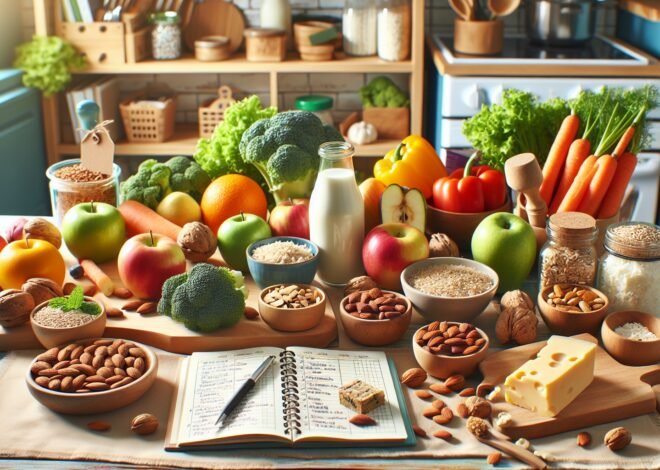
How to Avoid Hidden Dairy in Packaged Foods: Reading Labels
Avoid hidden dairy in foods is crucial for those with lactose intolerance or dairy allergies. An astonishing percentage of packaged foods contain dairy derivatives that aren’t immediately apparent. This guide will delve into reading labels effectively to identify ingredients that may include hidden dairy. From casein and whey to lactose and milk solids, understanding what to look for can significantly ease dietary restrictions. Read on to discover how to navigate label jargon, select safe products, and avoid unintentional exposure to dairy.
Understanding Dairy Ingredients in Packaged Foods
Dairy ingredients often find their way into many packaged foods. Whether for taste, texture, or nutritional value, these ingredients can be elusive. Understanding their presence requires keen observation and knowledge. This section will guide you through identifying common dairy ingredients, spotting derivatives on labels, and recognizing hidden dairy in food additives.
What Are Common Dairy Ingredients to Look For
Packaged foods often contain dairy components. These may include straightforward items like milk, cheese, butter, and cream. However, less obvious ingredients, like whey, casein, and lactose, also signal dairy presence. Knowing these terms is vital for anyone avoiding dairy.
- Milk and Cream: Found in sauces, baked goods, and even some snacks.
- Butter and Ghee: Common in pastries and various cooking oils.
- Cheese: Present in crackers, chips, and flavored snacks.
For those avoiding dairy, these ingredients can be problematic. They might not be listed under “dairy” but appear in various forms. Recognizing these terms helps manage a dairy-free diet effectively.
How to Identify Dairy Derivatives on Labels
Labels often hide dairy under various names. Identifying derivatives requires a keen eye. Common dairy derivatives include:
- Casein and Caseinate: Proteins derived from milk. Found in non-dairy creamers and protein bars.
- Whey: Another milk protein. Often used in protein powders and baked goods.
- Lactose: Milk sugar used in bread, processed meats, and cereals.
Understanding these names and their sources helps navigate labels better. Look for terms like “milk solids” or “curds” that also indicate dairy presence. Checking ingredient lists closely can prevent accidental dairy consumption.
Recognizing Dairy Ingredients Hidden in Food Additives
Food additives can conceal dairy ingredients. Additives often enhance flavor or preserve food, but some originate from dairy. Identifying these can be challenging but crucial.
- Natural Flavorings: Sometimes derived from dairy.
- Lactic Acid: Not always dairy-based, but can originate from milk.
- Sodium Lactate: Might sound non-dairy, but can come from milk.
Reading labels thoroughly and understanding these terms helps maintain a dairy-free diet. Manufacturers sometimes change formulations, so staying alert is key. Knowledge empowers better food choices and dietary adherence.
Tips for Reading Packaged Food Labels for Dairy-Free Eating
Reading food labels is an essential skill for anyone avoiding dairy. These labels can be tricky, with hidden terms and confusing jargon. This section provides tips on interpreting allergen statements, navigating ingredient lists, and understanding certifications for dairy-free products.
How to Interpret Allergen Statements for Dairy Ingredients
Allergen statements offer quick guidance on potential dairy presence. These statements are often bolded or highlighted on packaging. They inform consumers about common allergens, including dairy.
- “Contains Milk”: A clear indicator of dairy presence.
- “May Contain Traces of Milk”: Suggests cross-contamination risk.
- “Manufactured in a Facility that Processes Milk”: Implies potential dairy exposure.
These statements help those with allergies make informed choices. However, they might not catch all dairy derivatives. Therefore, a detailed ingredient check is always recommended.
Navigating Ingredient Lists for Hidden Dairy
Ingredient lists can be long and complicated. Hidden dairy ingredients may not be immediately obvious. This is where knowledge of dairy derivatives proves invaluable.
- Look for Specific Terms: Words like casein, whey, and lactose indicate dairy.
- Check for Common Additives: Certain additives might be dairy-based, as previously discussed.
- Beware of “Non-Dairy” Labels: These might still contain casein or other derivatives.
Reading ingredient lists carefully enables better dietary control. Misleading labels can lead to accidental dairy intake, so vigilance is necessary.
Understanding Food Label Certification for Dairy-Free Products
Certifications provide assurance of a product’s dairy-free status. These labels are helpful for consumers seeking guaranteed dairy-free options.
- Certified Dairy-Free: Indicates the product is safe for dairy-free diets.
- Vegan Certification: Often implies no dairy, but double-check for hidden derivatives.
- Kosher Pareve: Typically dairy-free, but verify based on specific dietary needs.
These certifications simplify the shopping process. However, staying informed about what these labels entail ensures complete dietary adherence.
Strategies for Avoiding Hidden Dairy in Your Diet
Avoiding hidden dairy requires strategic planning and awareness. From exploring dairy-free alternatives to maintaining an updated shopping list, these strategies will aid in eliminating dairy from your diet. Stay informed about ingredient changes to avoid unexpected dairy intake.
Exploring Dairy-Free Alternatives for Common Foods
Dairy-free alternatives are increasingly available. These options provide similar taste and texture without dairy complications.
- Milk Alternatives: Almond, soy, oat, and coconut milk replace traditional milk.
- Cheese Substitutes: Cashew and coconut-based cheeses offer flavor without dairy.
- Butter and Cream Replacements: Use oils or plant-based spreads for cooking and baking.
Experimenting with these alternatives can enhance meals. They are often fortified with nutrients, making them a healthy choice for dairy-free lifestyles.
Creating a Shopping List for a Dairy-Free Lifestyle
A well-prepared shopping list is crucial for maintaining a dairy-free diet. Planning ahead ensures access to necessary ingredients while avoiding dairy pitfalls.
- List Dairy-Free Staples: Stock up on plant-based milk, cheese, and yogurt.
- Include Fresh Produce: Fruits and vegetables are naturally dairy-free.
- Consider Packaged Snacks: Choose certified dairy-free options for convenience.
Organizing a list eliminates guesswork while shopping. It keeps the focus on dairy-free products, simplifying meal planning.
Staying Informed About Ingredient Changes in Packaged Foods
Manufacturers frequently alter ingredients, making vigilance crucial. Staying informed prevents accidental dairy consumption.
- Regularly Check Labels: Even trusted products can change formulations.
- Join Online Communities: Share information with others following a dairy-free diet.
- Sign Up for Manufacturer Updates: Some companies provide ingredient change notifications.
Awareness of potential changes ensures continued dietary compliance. This proactive approach safeguards against unexpected dairy exposure.
Conclusion
Hidden dairy is commonly found in processed foods, baked goods, and certain condiments. Reading ingredient labels is crucial for identifying dairy derivatives like casein, whey, or lactose. Phrases such as natural flavors or seasoning might also indicate dairy presence. Some foods labeled as nondairy or vegan might still contain trace amounts of dairy. Cross-contamination during manufacturing processes can lead to unintentional dairy content.
FAQ
What are common foods that might contain hidden dairy ingredients?
Many processed foods can surprisingly contain hidden dairy. Some common culprits include baked goods like bread and cookies, deli meats, salad dressings, and even some chips. Always check for cheese, butter, or milk derivatives.
How can I identify hidden dairy in packaged foods?
Reading ingredient lists is crucial. Look for terms like casein, whey, lactose, and milk solids. These indicate the presence of dairy. Also, “natural flavors” can sometimes contain dairy components, so when in doubt, contact the manufacturer.
Are there dairy-free alternatives that are safe for lactose-intolerant individuals?
Yes, there are many lactose-free options available. Almond milk, soy milk, and coconut milk serve as excellent substitutes. You can also find dairy-free cheese, yogurt, and ice cream made from nuts or soy.
What are some surprising sources of hidden dairy in restaurant meals?
Restaurant meals often contain hidden dairy in sauces, soups, and marinades. Mashed potatoes might have butter or cream, and even some grilled dishes are brushed with butter. Always ask the server about potential hidden dairy.
How do food labels indicate the presence of dairy in ingredients?
Food labels must list potential allergens, including milk. Look under the ingredients list for “contains milk” or similar statements. These are usually bolded to help consumers identify allergens easily.
What steps can I take to avoid hidden dairy in my diet?
Start by reviewing ingredient lists carefully and choosing fresh, whole foods. Opt for certified dairy-free products and ask questions when dining out. Educating yourself about dairy derivatives helps in making informed choices.











